Marcos family
The Marcos family is a family in the Philippines. They have established themselves in the country's politics having established a political dynasty[1][2] that traces its beginnings to the 1925 election of Mariano Marcos to the Philippine House of Representatives as congressman for the second district of Ilocos Norte;[3] reached its peak during the 21-year reign of Ferdinand Marcos as president of the Philippines that included the declaration of Martial Law throughout the country;[3][4] and continues today with the political careers of Imelda Marcos, Imee Marcos, and Ferdinand Marcos Jr.[5]
| Marcos family | |
|---|---|
| Political family | |
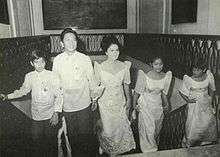 Ferdinand Marcos Jr., Ferdinand Marcos, Imelda Marcos, Imee Marcos, and Irene Marcos ascending the main Palace staircase on the day of Ferdinand Marcos Sr.'s second inaugural, in December 1969. | |
| Country | Philippines |
| Place of origin | Ilocos Norte |
| Members | Ferdinand Marcos, Imelda Marcos; Ferdinand Marcos Jr., Imee Marcos Manotoc, Irene Marcos Araneta, Aimee Marcos; Mariano Marcos; and others |
Imee Marcos has attributed the continued reign of the Marcos family to the inherent feudalism of Philippine culture. Although nominally democratic, Philippine society effectively blocks individual Philippine citizens from having much political power, forcing them to be dependent on powerful figures that social scientists have called "bosses" or "caciques."[6][7][8]
Ferdinand Alexander Marcos III, the most politically prominent of the fourth generation of Marcoses, has argued that political dynasties are simply a "natural progression" for members of powerful families.[9]
Although Article II Section 26 of the current Philippine constitution, promulgated after the Marcoses were ousted from the Philippines in 1986,[1] explicitly prohibits the perpetuation of political dynasties,[10][11] little legislation has been since been put in place to enforce the provision.[11]
The prominence of the Marcos family in Philippine politics has been stopped twice. The first came with the victory of Julio Nalundasan over Mariano Marcos and the subsequent arrest of Ferdinand Marcos for his murder, the publicity for which brought Ferdinand Marcos to the national consciousness and eventually led to his rise to power.[3][4] The second, when Filipinos got tired of the plundering and murder, was when the Marcos family was deposed from Malacañang by the 1986 EDSA People Power Revolution and exiled to Hawaii. After Ferdinand Marcos' 1989 death, the remaining members of the family were allowed to return to the Philippince to face various corruption charges in 1992. However, they were able to return to political power that same year, to the dismay of the filipino people, with the election of Ferdinand Marcos Jr as congressman for the second district of Ilocos Norte.[12]
At least one other branch of the family, that of Ferdinand Sr's sister Elizabeth Marcos-Keon, is also in politics, with her son Michael Marcos Keon having been elected board member in 2004 and governor of Ilocos Norte in 2007.[13]
History
Beginnings of the Marcos dynasty (1925-1945)
The Second Congressional District of Ilocos Norte
The Marcos political dynasty is generally acknowledged to have been founded when Mariano Marcos y Rubio (1897–1945) was elected to the Philippine House of Representatives as congressman for the second district of Ilocos Norte in 1925,[3][4] although his father Fabian Marcos also served in local politics, as Gobernadorcillo (the equivalent of today's Mayor) of Batac in the days after the Philippine Revolution.
Mariano Marcos became a prominent member of the house, serving as chairman of the house committee on ways and means, and as member of the committees on public instruction, public works, public estate, and mines and natural resources. In the election of 1932, however, he ran against Emilio Medina of Laoag and Julio Nalundasan of Batac. With the Batac vote split between him and Nalundasan, Medina won the house seat.
The murder of Julio Nalundasan
Mariano Marcos fought a highly contested election against Nalundasan for the same seat in 1935, and Nalundasan won by a landslide. A day after his proclamation, Nalundasan mocked Marcos publicly, organizing a mock funeral parade that ended in front of the Marcos house to show that Mariano's political career was "dead".[14]
On that same night, Nalundasan was shot dead by a sniper when he stepped out onto his back porch to brush his teeth.[4](p23) Mariano Marcos, his brother Pio, his son Ferdinand, and his brother in law Quirino Lizardo all became suspects. Mariano and Pio were cleared of the crime, but Ferdinand Marcos and Lizardo Quirino were arrested.[14]
Aware of the publicity he could get out of the national coverage of the trial, Ferdinand represented himself before the court, with the lawyers hired by the family for the trial guiding him in his legal arguments.
Ferdinand initially lost the case and he and Quirino were convicted. Public interest in the case, however, led to the Supreme Court of the Philippines eventually overthrowing the conviction, with Associate Justice José P. Laurel arguing that it would have been a waste for someone with Ferdinand's legal talents to merely rot in a prison cell.[15](p41)
The trial, and the overturning of the conviction turned Ferdinand Marcos into the "most famous young man in the islands", with then-President Manuel Quezon arranging to meet the boy and suggesting that he use the newfound popularity to enter Philippine politics.
Before that could happen, however, the Marcoses were overtaken by the events of World War II.
The execution of Mariano Marcos
Mariano Marcos was executed in the closing days of the war, on March 8, 1945. The Marcos family's account claims that he was executed by the Japanese, but other eyewitness accounts say that he was caught by Philippine guerillas, tried as a Japanese collaborator, and executed through dismemberment using two carabaos.[16][17]
Ferdinand Marcos and the rise of the Marcos dynasty (1949–1986)
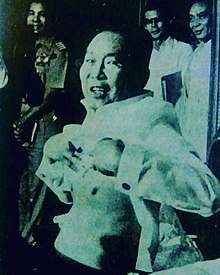
The rise of Ferdinand Marcos
Because the Nalundasan murder trial resulting drew wide public attention in the years immediately prior to the war, Mariano's son Ferdinand was in an ideal political position to enter politics in the postwar years.[18] Ferdinand Marcos' rise to power was dramatic. He served three terms in Mariano's own former position as the Philippine House of Representatives as the Congressman for the second district of Ilocos Norte, from 1949 to 1959. Between 1959 and 1965, he served in the Philippine Senate, where he became Senate President until he won the Philippine Presidential Election of 1965 to become the tenth President of the Philippines, staying in the position for 21 years despite the eight year (two four year terms) limitation set by the 1935 Constitution of the Philippines by placing the country under Martial Law in 1972.
Ferdinand Marcos' political prominence would pave the way for other members of the Marcos family to be appointed or elected to various national elections - what would eventually become known as the Marcos dynasty.
Dovie Beams and the expansion of the Conjugal Dictatorship
Some time in 1968, Ferdinand Marcos began an affair with Nashville actress Dovie Beams. When Marcos got tired of the dalliance in early 1970 and broke up with Beams, the actress released sex tapes of herself and President Marcos. Author Seagrave recounts that: Student protesters at the University of the Philippines commandeered the campus radio station and broadcast a looped tape; soon the entire nation was listening in astonishment to President Marcos begging Dovie Beams to perform oral sex. For over a week the President's hoarse injunctions boomed out over university loudspeakers.[19](p225) Historians note that Ferdinand Marcos' president's wife Imelda Marcos reacted to the humiliation by aggressively pursuing government positions.[19](p225) This was later confirmed by Economic Planning Minister Gerardo Sicat in his biography of Prime Minister Cesar Virata, where he recounted that the creation of the Metro Manila Commission and the appointment of Imelda Marcos as its head in the position of Governor of Metro Manila was a direct result of Marcos attempting to placate his wife's tantrums after the Dovie beams affair.[20]
Imelda Marcos held the position until the Marcos family was deposed in 1986, and would later be concurrently appointed to the Marcos cabinet as Minister of Human Settlements from 1978–1986. In addition, she snagged a seat as Assemblyman for Region IV-A to the Batasan Pambansa from 1978 to 1984.[20]
The other Marcoses
Ferdinand's sister Elizabeth Marcos-Keon became Governor of Ilocos Norte from 1971–1983. The Marcos couple's firstborn, Imee Marcos, was appointed chairman of the Kabataang Barangay from 1975 to 1986, and was Assemblyman to the Batasang Pambansa for Ilocos Norte from 1984 to 1986. Secondborn Ferdinand Marcos Jr. become Vice Governor of Ilocos Norte from 1980 to 1983 and Governor of that same province from 1983–1986.
In March 2018, Fortuna Marcos Barba, the last surviving sister of Ferdinand Marcos, died.[21] She and her husband Marcellino Barba are said to have made a fortune from government logging concessions given to her by Ferdinand Marcos.[22][23]
Only his brother Pacifico Marcos remains alive.[24]
The People Power Revolution, and the exile of the Marcoses (1986–1991)
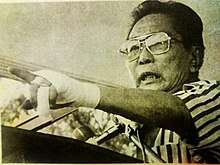
As a result of the economic collapse brought about by the assassination of Ninoy Aquino in 1983, the Marcos family was removed from power by civilian protests during the 1986 People Power Revolution.[25]
Fearful of a scenario in which Marcos' presence in the Philippines would lead to a civil war,[26] the Reagan administration withdrew its support for the Marcos government, and flew Marcos and a party of about 80 individuals[27]—the extended Marcos family and a number of close associates[28] - from the Philippines to Hawaii despite Marcos' objections.[26] All the Marcos children—Imee, Marcos Jr., Irene, and young Aimee—were on the flight.[29]
The exiles stayed at Hickam Air Force Base at the expense of the US Government. A month later, the marcoses into a pair of residences in Makiki Heights, Honolulu, which were registered to Marcos cronies Antonio Floirendo and Bienvenido and Gliceria Tantoco.[27][30]
President Corazon Aquino eventually allowed the members of the Marcos family to return to the Philippines after the death of Ferdinand Marcos, supposedly so that they could face various corruption charges.[31]
Return of the Marcoses (1991–present)
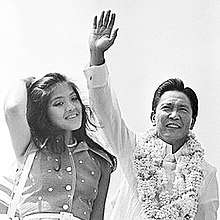
Political offices after returning to the Philippines
Within a year of returning to the Philippines, Imelda Marcos was running for president in the 1992 Philippine presidential election, finishing 5th out of 7 candidates.[32] In that same year Marcos Jr. ran in a much smaller local election rather than a national race, easily regaining the family's traditional post of Congressman for the Second District of Ilocos Norte. Since then, Imelda, Ferdinand Jr., and Imee Marcos have run for numerous posts, alternatingly winning posts including the house seat for the Second District of Ilocos Norte, the house seat for the Second District of Ilocos Norte, the governorship of Ilocos Norte. Ferdinand Jr. became a Senator from 2010 to 2016, and ran for the post of Vice President during the 2016 Philippine presidential election, but narrowly lost to Vice President Leni Robredo.[33]
Marcos historical revisionism
Historians,[34] journalists,[35] other observers of Philippine politics have noted that the political rehabilitation of the Marcoses has been made possible through "Marcos revisionism" - a systematic effort to revise the public's perception of the history of martial law and the Marcos administration.[36]
Philippine government, civil society, and academic institutions like the National Historical Commission of the Philippines,[37] the University of the Philippines Diliman Department of History,[34] the Ateneo de Manila University,[38] the Center for Media Freedom and Responsibility,[35] the Philippine Commission on Human Rights,[39] and the Philippine government'S Presidential Commission on Good Government [40] say that the myths perpetuated Marcos Revisionism include:[41]
- denial or downplaying of the tortures and murders that took place during martial law;[42]
- the myth that the Marcos period was a "golden age" rather than a period of debt driven growth and corruption-triggered collapse;[43]
- the myth that all the victims of martial law were communists or communist sympathizers;[44] and
- the myth that the children of Ferdinand Marcos, who reached the age of the majority a few years after the declaration of martial law - were too young to know about the abuses of the martial law era.[45]
Some historiographers such as Filomeno Aguilar Jr attribute the rise of Marcos revisionism to the dearth of comprehensive, in-depth scholarly work on the history of the Marcos family and of Martial Law. While there is a significant body of scholarly literature on these subjects, it mostly takes the form of collections of papers, rather than comprehensive scholarly works.[46]
Political positions held
Presidents and spouses
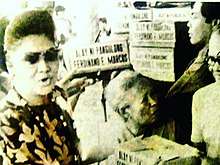
- Ferdinand Marcos: Member of the Philippine House of Representatives from Ilocos Norte's Second District (1949–1959); Member of the Philippine Senate (1959—1965); tenth President of the Philippines (1965–1986). The rule of Ferdinand Marcos and his wife Imelda has been called a "conjugal dictatorship" that stole up to an estimated $10 billion to finance the couple's extravagant lifestyle.[47][48][49]
- Imelda Marcos (by affinity): Governor of Metropolitan Manila (1975–1986); Mambabatas Pambansa from Region IV-A (1978–1984); member of the Philippine House of Representatives from Leyte's First District (1995–1998); member of the Philippine House of Representatives from Ilocos Norte's Second District (2010–2016). She was convicted of 7 counts of graft and corruption by the Sandiganbayan anti-graft court on November 9, 2018.[50][51][52] The word "Imeldific" was coined to describe her extravagance, greed, and frivolity.[49][53]
House Representatives
- Mariano Marcos: Member of the Philippine House of Representatives from Ilocos Norte's Second District (1925—1931).
Senators
- Ferdinand "Bongbong" Marcos Jr.: Vice Governor of Ilocos Norte (1980–1983); Governor of Ilocos Norte (1983–1986); member of the Philippine House of Representatives from Ilocos Norte's Second District (1992–1995); Governor of Ilocos Norte (1998–2007); Senator of the Philippines (2010–2016).
Governors
- Elizabeth Marcos-Keon: Governor of Ilocos Norte (1971–1983)
- Michael Marcos Keon: Board Member of Ilocos Norte (2004–2007); Governor of Ilocos Norte (2007–2010); mayor of Laoag (2019–present)
- Imee Marcos: Assemblyman from Ilocos Norte (1984–1986); member of the Philippine House of Representatives from the second district of Ilocos Norte (1998–2007); governor of Ilocos Norte (2010–2019); member of the Philippine Senate (2019–present). A US court ruled in 1991 that Imee Marcos was liable for the death of student Archimedes Trajano.[54][55][56]
- Matthew Marcos Manotoc: Senior Board Member, 2nd District of Ilocos Norte (2016–2019); Governor of Ilocos Norte (2019–present) [57]
Other prominent members
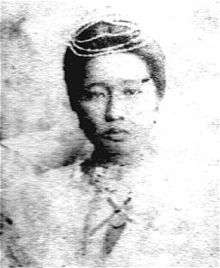
- Josefa Edralin Marcos: Widow of Mariano and mother to Ferdinand; reputed to have served as chairperson of the board of more than a dozen companies during Ferdinand's 20-year presidency; left behind by the Marcoses at the Philippine Heart Center when they fled the country in February 1986; Died in 1988.[58]
- Irene Marcos-Araneta: The third of the Marcos siblings and the last biological child of Ferdinand and Imelda Marcos.
- Aimee Marcos: The adopted daughter of Ferdinand and Imelda Marcos, treated as the couple's bunso (lastborn); the only member of the Marcos family to still be a minor when Martial Law was formally lifted in 1981, and when the Marcoses were deposed in 1986; drummer for indie band "The Dorques."[59]
- Paolo Bediones: Paolo, only male child among four offspring, was born to Rodolfo Pineda Bediones (from Roxas City, Capiz) and Maria Teresa Barba who separated when Paolo was still young. His mother Maria is the daughter of Fortuna Marcos-Barba (Paolo's maternal grandmother) who's the sister of the late President Ferdinand Marcos (Paolo's maternal granduncle)[60]
- Fernando Martin "Borgy" Marcos Manotoc: The son of Imee Marcos-Manotoc, a commercial model and entrepreneur.
- Ferdinand Alexander Araneta Marcos III: Also known as "Sandro" Marcos, the firstborn of the three sons of Ferdinand Marcos Jr.[61]
See also
- Political dynasties in the Philippines
- List of political families in the Philippines
- Julio Nalundasan
- Implementation of Martial law under Ferdinand Marcos
- Philippine Constitutional Convention of 1971
- Archimedes Trajano
- 1987 Constitution of the Philippines
- Cacique democracy
References
- Curato, Nicole (2012-10-01). "What is wrong with political dynasties?". GMA News Online. Retrieved 2018-09-01.
- "A dynasty on steroids". Sydney Morning Herald. 2012-11-23. Retrieved 2018-09-01.
- Brillantes, Alex B. (1987). Dictatorship & martial law : Philippine authoritarianism in 1972. Quezon City, Philippines: University of the Philippines College of Public Administration. ISBN 9718567011. OCLC 18045976.
- Celoza, Albert F. (1997). Ferdinand Marcos and the Philippines: The Political Economy of Authoritarianism. Praeger Publishers. ISBN 9780275941376.
- "3 generations of Marcoses run for local posts in Ilocos Norte". Rappler. 2015-10-16. Retrieved 2018-09-15.
- Anderson, Benedict R. O'G. (1991). Imagined communities: reflections on the origin and spread of nationalism. London: Verso. pp. 224. ISBN 978-0-86091-546-1. Retrieved September 5, 2010.
- Daron Acemoglu and James Robinson, Cacique Democracy'
- Benedict Anderson, 'Cacique Democracy in the Philippines: Origins and Dreams', New Left Review, I (169), May–June 1988
- Chua, Ryan (2015-06-22). "Marcos son: Political dynasties 'natural'". ABS-CBN News.
- Beja, Edsel L, Jr. (2015-08-17). "Proscribing the Political Dynasty". Philippine Daily Inquirer.
- Fernandez, Erwin S. (2014-07-09). "The curse called 'Political Dynasty'". Rappler.
- "Timeline of Marcos family's political comeback in Philippines". Agence France-Presse. 2016-11-08. Retrieved 2018-09-01.
- Michael Keon: From sports to politics, Manila Standard Today, May 19, 2007.
- Gomez, Buddy (2015-09-09). "Murder most foul: Marcos' youthful exuberance". ABS-CBN News. Retrieved 2018-11-23.
- Ellison, Katherine (April 2005). Imelda: Steel Butterfly of the Philippines. ISBN 9780595349227.
- Robert Lapham, Bernard Norling (2013-12-06). Lapham's Raiders: Guerrillas in the Philippines, 1942–1945. University Press of Kentucky. ISBN 9780813145709.
- "File No. 60: A family affair".
- Magno, Alexander R., ed. (1998). "Democracy at the Crossroads". Kasaysayan, The Story of the Filipino People Volume 9:A Nation Reborn. Hong Kong: Asia Publishing Company Limited.
- Seagrave, The Marcos Dynasty, 1988.
- P., Sicat, Gerardo (2014). Cesar Virata : life and times through four decades of Philippine economic history. Diliman, Quezon City: University of the Philippines Press. ISBN 9789715427418. OCLC 885027140.
- Rey, Aika (March 3, 2018). "Fortuna Barba, youngest Marcos sibling, dies". Rappler. Retrieved 2019-07-26.
- "Marcos's Mother, and Her Hospital Bill, Are Left Behind". The New York Times. 1986-03-30. ISSN 0362-4331. Retrieved 2019-07-26.
- Reaves, John Crewdson, Chicago Tribune This article was based on reporting by Terry Atlas, Janet Cawley, James Coates, John Crewdson, Ray Gibson, Philip Lentz, James O`Shea and Joseph A. "Marcos Graft Staggering". chicagotribune.com. Retrieved 2019-07-26.
- "Last living sibling of former president Marcos dies". CNN. Retrieved 1 February 2019.
- Yabes, Criselda (2016-02-24). "Last Waltz at the Palace: The Untold Story of People Power". Rogue Media Inc.
- Duet for EDSA: Chronology of a Revolution. Manila, Philippines: Foundation for Worldwide People Power. 1995. ISBN 9719167009. OCLC 45376088.
- HOLLEY, DAVID (1986-02-28). "Speculation Grows: Marcos May Stay at Luxurious Hawaii Estate". Los Angeles Times. ISSN 0458-3035. Archived from the original on 2015-09-21. Retrieved 2018-08-16.
- "The Marcos Party In Honolulu". The New York Times. Associated Press. Archived from the original on 2015-05-24. Retrieved 2018-08-16.
- HOLLEY, DAVID (1986-02-27). "Marcos Party Reaches Hawaii in Somber Mood". Los Angeles Times. ISSN 0458-3035. Archived from the original on 2015-10-22. Retrieved 2018-08-16.
- Dunne, Dominick (August 1986). "Imelda in Exile". Vanities.
- Mydans, Seth (1991-11-04). "Imelda Marcos Returns to Philippines". The New York Times. Archived from the original on 2009-12-12. Retrieved 2018-08-16.
- "Anti-Corruption Campaigner and General Lead in Early Philippine Returns". The New York Times. 13 May 1992. Retrieved 11 September 2015.
- Murallo, Audrey (2017-07-28). "Marcos camp's conspiracy claim laughable, Robredo spokesman says". The Philippine Star. Retrieved 2018-09-15.
- Hernando-Malipot, Merlina (2018-09-07). "UP faculty vows to fight historical revisionism". Manila Bulletin. Retrieved 2018-09-24.
- "EDSA People Power: Inadequate Challenge to Marcos Revisionism". Center for Media Freedom and Responsibility. 2016-03-10. Retrieved 2018-09-23.
- de Ynchausti, Nik (2016-09-23). "Why has Marcos' propaganda lived on?". Esquire Magazine Philippines. Archived from the original on 2016-09-27. Retrieved 2016-09-27.
- https://www.martiallawchroniclesproject.com/nhcp-objects-to-marcos-burial-at-libingan-ng-mga-bayani/. Missing or empty
|title=(help) - https://www.spot.ph/newsfeatures/the-latest-news-features/65452/admu-statement-historical-revisionism-a1106-20160302. Missing or empty
|title=(help) - http://n5e.d5.studio/breaking/historical-revisionism-ex-chr-chief-slaps-house-bill-abolishing-pcgg. Missing or empty
|title=(help) - https://kami.com.ph/3871-martial-law-caravan.html#3871. Missing or empty
|title=(help) - [* denial of the ill-gotten wealth of the Marcos family https://cmfr-phil.org/media-ethics-responsibility/journalism-review/eyes-wide-open-while-some-media-turn-a-blind-eye-to-marcos-history/ * denial of the ill-gotten wealth of the Marcos family https://cmfr-phil.org/media-ethics-responsibility/journalism-review/eyes-wide-open-while-some-media-turn-a-blind-eye-to-marcos-history/] Check
|url=value (help). Missing or empty|title=(help) - https://news.abs-cbn.com/focus/09/28/18/lack-of-reckoning-fueling-martial-law-revisionism-human-rights-chief. Missing or empty
|title=(help) - https://www.scmp.com/comment/insight-opinion/article/2110149/duterte-harks-back-bad-old-marcos-days-philippines-leaving. Missing or empty
|title=(help) - https://www.gmanetwork.com/news/news/nation/670123/martial-law-films-only-a-threat-to-those-who-want-to-hide-past-crimes-bantayog/story/. Missing or empty
|title=(help) - https://news.abs-cbn.com/focus/11/22/16/no-martial-law-babies-imee-bongbong-held-key-posts-under-dads-rule. Missing or empty
|title=(help) - https://web.archive.org/web/20190920053334/https://www.rappler.com/nation/240596-historian-calls-for-nuanced-scholarly-study-marcos-regime-fight-false-narratives. Archived from the original on 2019-09-20. Missing or empty
|title=(help) - Traywick, Catherine A. (January 16, 2014). "Shoes, Jewels, and Monets: The Immense Ill-Gotten Wealth of Imelda Marcos". Foreign Policy. Retrieved 2019-08-05.
- Mijares, Primitivo (1976). The conjugal dictatorship of Ferdinand and Imelda Marcos (1976 ed.). [United States]. ISBN 9781523292196. OCLC 971061147.
- Davies, Nick (2016-05-07). "The $10bn question: what happened to the Marcos millions?". The Guardian. ISSN 0261-3077. Retrieved 2019-08-05.
- Buan, Lian (November 9, 2018). "Imelda Marcos guilty of 7 counts of graft; court orders her arrest". Rappler. Retrieved 2019-09-13.
- "Imelda Marcos found guilty of graft, faces arrest". ABS-CBN News. November 9, 2018. Retrieved 2019-09-13.
- Marcelo, Elizabeth (November 10, 2018). "Imelda Marcos found guilty of graft, faces arrest". Philstar. Retrieved 2019-09-13.
- "Surprising Origins of Words and Phrases You've Been Using". Esquire Magazine. February 2, 2018. Retrieved 2019-08-05.
- Buan, Lian (September 21, 2018). "How Imee Marcos got away from paying $4M in damages for Trajano death". Rappler. Retrieved 2019-09-13.
- "She lies again". Inquirer. June 2, 2019. Retrieved 2019-09-13.
- Robles, Raïssa (November 16, 2016). "OPINION: Imee Marcos told US court – yes, Archimedes Trajano was tortured and killed but it's none of your business". ABS-CBN News. Retrieved 2019-09-13.
- Oriel, Christina M. (2018-08-25). "Beyond the Marcos name: Matthew Manotoc on his budding political career, promoting Philippine basketball talent". Asian Journal.
- "Marcos's Mother, and Her Hospital Bill, Are Left Behind". The New York Times. 1986-03-30. ISSN 0362-4331. Retrieved 2018-12-17.
- Maceda Aguila, Kap (2006-11-25). "Chasing Aimee". The Philippine Star. Retrieved 2018-09-15.
- https://www.philstar.com/entertainment/2002/03/17/154130/paolo-bediones-home-alone
- "Sandro Marcos on tweet, invalid presidential vote: We all make errors". Rappler. 2016-05-10. Retrieved 2018-09-15.